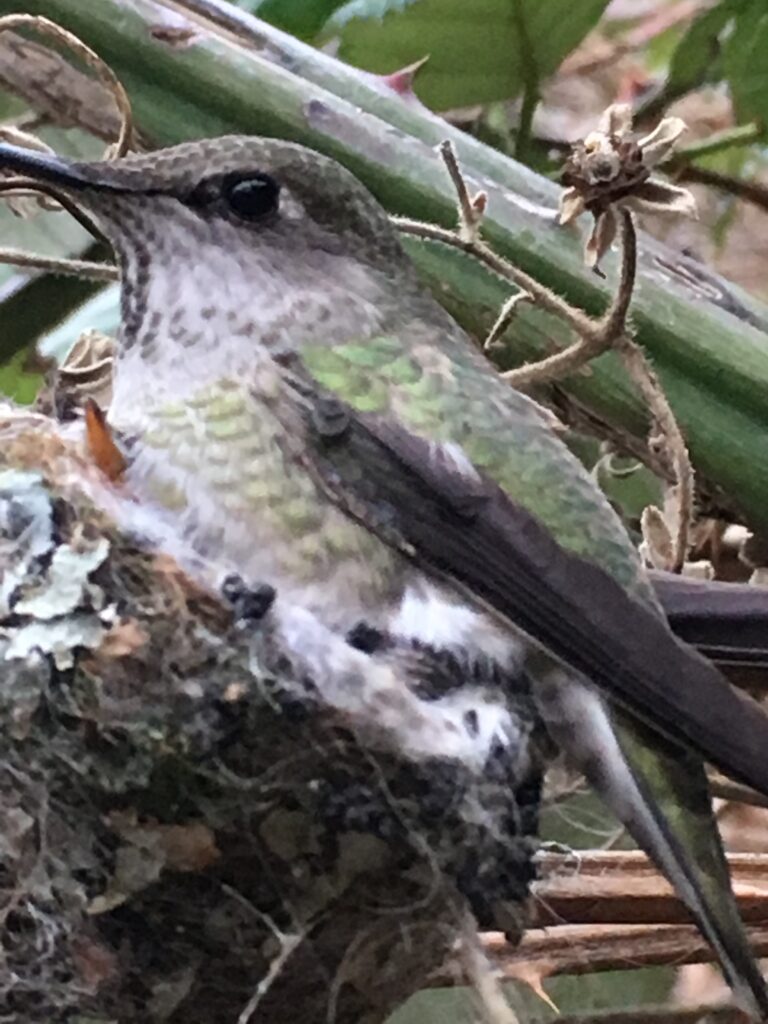
By Sarah Lyon
There’s a flutter of feathered activity at a point along the dirt path that rises above the shoreline close to Kits Beach in Vancouver. Two, sometimes three hummingbirds dart between a sap-laden pine and other bushes set back from this well-trodden path. It becomes part of my daily morning ritual to stop and hum a prayerful chant to them. As I do, these jewel-like creatures appear as if from nowhere. I feel welcomed in.
In some indigenous traditions, hummingbirds are thought to be messengers that heal the body and soul and guide one through life’s challenges. The birds are a symbol of love, joy and a reminder to shed negativity through a positive mindset. Negativity is no stranger to me.
Listening to a litany of internal negative thoughts, I desire to shed the shadowy feelings I have felt cloaked in these recent months. A cloak stitched through with a thread of paralyzing uncertainty about reinventing both my professional and personal lives. Self-esteem and confidence are at a low. A tightness consumes my solar plexus. Having returned to my native Canada after a life lived abroad, I am in midlife terrain feeling the loss of the community I belonged to in the UK—a community where everyone knew me and more importantly where I knew me. To add to this, my empty nest feels emptier. My adult children have long ago taken flight yet I am lonesome. I long to nestle into the comfort of what I know to be the core of who I am.
I need to move through these constrictions, loosen their grip — hum, sing, dance, walk. So I do. I promise to accept the presence of the little hummers as a gift of love and joy.
I will find a new way of belonging. A new way of being me.
“I tried to gently guide the olive-green-and-peach coloured hummingbird with my hands but it only began to panic more and I feared it would have a heart attack,” she writes. “My farm girl instincts took over and I knew I had to help so I quickly scooped it up in my hands and let it go at the bottom of the stairs. After it flew away I looked at my hand and it was covered in an iridescent sheen like the powder left behind by butterfly wings. And in my palm were four tiny precious feathers.”
On the days when the hummingbirds are out of sight, I imagine the image of a hummingbird with its wings stretched out across my body. It is a powerful, playful image like a hologram, of shimmering colour intensely alive to me. Even more bewildering, I begin to notice images of hummingbirds everywhere. They come as tokens, gifts, and cards that continue to arrive from both the UK and Canada. Then one day my beautiful niece hands me a large white and folded envelope. Within it is a note and four very small shimmering feathers gathered after she’d rescued a hummingbird trapped and thrashing against the window, inside their family farm on Vancouver Island. “I tried to gently guide the olive-green-and-peach coloured hummingbird with my hands but it only began to panic more and I feared it would have a heart attack,” she writes. “My farm girl instincts took over and I knew I had to help so I quickly scooped it up in my hands and let it go at the bottom of the stairs. After it flew away I looked at my hand and it was covered in an iridescent sheen like the powder left behind by butterfly wings. And in my palm were four tiny precious feathers.”
I place the feathers, a gift of love, in a small ornamental dish on my dresser like an altar.
The poet Emily Dickinson once wrote:
“Hope is the thing with feathers,
That perches in the soul.”
Here, on my tiny altar, and in my soul, I feel hope revitalized. I liken it to the feathered bird that is forever perched in each one of our souls illuminating the desire for love and creativity. The hummingbird feathers are like a Holy offering. Sacred. The frequent sightings yield far more than I could have anticipated. Each contact with the more-than-human is a gift of Pure Joy. With grace and power the birds are helping me to feel a sense of belonging. A new song in my soul wants to take flight.
I am reading Laurie Sarkadi’s book Voice in the Wild where she describes how she too underwent a profound transformation during a time of upheaval, a time she describes as an awakening to a heightened consciousness. Her story echoes my own.( Laurie lives in Yellowknife in the Northwest Territories of Canada.) I feel compelled to hold tight to her words:
“Through serendipitous encounters with people near and far, I became aware of powerful forces that could protect and guide me and were intrinsically linked to nature. As I sought to better understand this relationship, I came to look upon animals, birds and insects as messengers providing clues to a deeper and more meaningful way to interpret my life and redirect my energies.”[1]
My early morning walks become a daily pilgrimage to where the hummingbirds hum and thrum. I quite naturally move into a meditative mood. A flow of solitude. I come to understand that my experiences in nature are helping me to learn more about myself. Being with the familiarity and movement of the walk, the trees, the ocean waves, the birds, is a profound homecoming.
The more curious and intentional I become about these regular, yet mystery-filled sightings, the more the hummingbird reveals herself. My hearing is acutely attuned to the breathy vibrational movement of her wings. I hear an indistinct flutter to my left, a familiar vibrating sound. I catch a slight movement in the overgrowth, choked with brambles. Turning my head ever so slightly, my eye spies the tiniest of nests with the little hummingbird perched atop. She is the builder of this miniature yet perfectly formed nest. A protective single parent, she will lay one or two eggs deep into the well of this magical weave. I observe a delicate, yet robust braid of minute twigs woven through with spiders’ silk and crowned in downy white feathers. It’s anchored and tightly secured to the intersection of two skinny branches. I am in awe of her innate skill to build a structurally sound home. A nest is my need too. We are glancing at each other. One female to another.
She is resilient.
Aware of her surroundings.
She’s resourceful.
A survivor.
Using what is available to her in nature to create a new nest.
Our challenges mirror the others.
Naming these shared strengths is empowering.
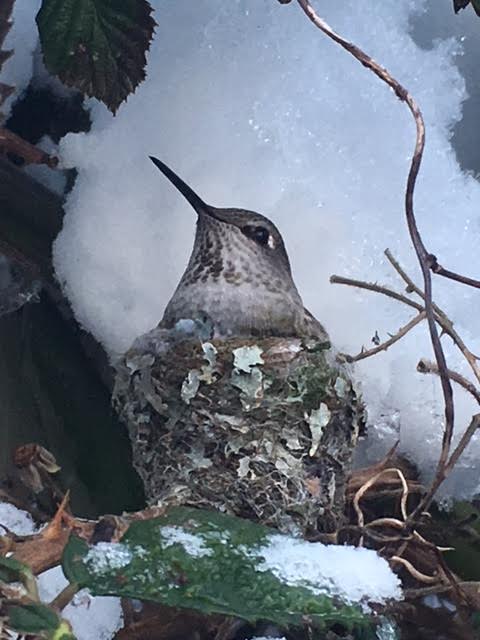
Photo by Sara Lyon
It’s mid-winter. The snow is heavy and compact. It weighs down the slight branches that support her nest. If only I could prop up an umbrella to shelter her. Install a canopy of protection. At eye level her nest is so close, I could reach out my hand to touch them both. I imagine sweeping her up in my hands in an offering of warmth and protection from the harsh elements. As if she’s read my thoughts, she darts out of her nest to encircle me, as if to acknowledge my presence. My desire is to feel welcomed in, yet I have to consider that she wants to protect her nest—that my presence is more likely a threat than one of connection. Desiring to be friend not foe I move along the path to give her space.
My need is to connect on a deeper level of knowing. What are the legends, origin stories, myths and poems of hummingbirds and what can these tales tell me of their character? As if the whole of the universe has heard my yearning, I come across “Flight of the Hummingbird“—a short animated film created by Christopher Auchter. The author of the story, Haida artist Michael Nicoll Yahgulanaa tells the tale of a little hummingbird who would not abandon a forest engulfed by fire. Instead of fleeing she confronts the challenge of a blazing forest. She flies to the stream back and forth with single drops of water in an effort to extinguish the raging fire. The dangers of the smoke and heat do not deter her. The little hummingbird persists ‘bead by bead’. It’s a story of survival. One of resilience. The bear, the bunny and the owl ask what she is doing risking her life in this way. “I am doing what I can,” she says.[2] This parable-like story resonates with me. Standing up to the fear. Wanting to save her home forest. Her message becomes my own. I repeat and tell myself,
I am doing what I can, I am doing what I can, I am doing what I can.
To take responsibility for the challenges. To live with the uncertainties of not knowing. To find a place of belonging in this new land. Like Hummingbird—who returns to her forest after years of flying the world—I too have returned, albeit disorientated, to the forest of my native Canada. I don’t know what the outcome is going to be, but I am doing what I can. I ask myself, “What does it take to feel at home in a proper nest?”
Then without warning the affirmation arrives. My older son phones me. He has concerns about me living solo in Vancouver. It’s March 2020 when the province of British Columbia, and the rest of the world, is entering Covid-19 lockdown protocols.
“What if the roads in and out of Vancouver are blocked, policed or both,” he says, concern echoing in his voice. “We won’t be able to help you. And what if the people living above you become sick?”
His concerns become mine and there is relief at the thought of leaving here and Vancouver.
“I am devoted to my close family,” he says. “We need to stick together and support each other.” His words offer a canopy of protection. I feel deeply cared for. There’s no point in resisting and I don’t need convincing.
The timing of my son reaching out is exquisite, possibly what Jung meant by the term synchronicity. I’d just moved to a new basement suite but I am not yet settled. It’s not a good fit and does not feel like home. Boxes are left unpacked and I am ready to move. To go now. To have the daily companionship of my family is something I have missed. To be in a nest again in this new way proves to be my Covid-19 silver lining.
It’s the final run with my son’s pick-up. As he secures the load for the drive east to Maple Ridge I follow the crooked concrete slabs back through the garden to the basement suite I have been living in for the past ten days. And as I do, I notice a shimmering of activity alight directly in front of me. A hummingbird! She hovers, holds her pose, as if to say, “You are doing the right thing”. Excited, I feel childlike in my body—jubilant and smiling. I imagine that she is waving me off to my new home with blessings of love and joy. It’s a promise fulfilled. In response and with arms outstretched my impulse is to offer up the familiar hymnal hum I know from my time on that well-trodden path above the shoreline at Kits Beach. It’s as if the hummingbird recognizes my simple yet prayerful chant. Something of my inner experience—the joy, the rapturous awe, is mirroring the external experience of encountering the hummingbird. In the joy there is healing and I am made more whole through the togetherness. The timing is powerful and holds affirmation for me. I am heading to a new nest. A nest where I will be with my sons, daughter-in-law and grandson. This is where I belong. In this familial flock.
Permissions
Excerpt from Voice in the Wild printed with kind permission from the author Laurie Sarkadi and publisher Caitlin Press.
Excerpts from “Flight of the Hummingbird” printed with kind permission from author Michael Nicoll Yahgulanaa.
[1] Laurie Sarkadi (2016) Voice in the Wild. Caitlin Publishing, p.xiv.
[2] Flight of the Hummingbird, (https://mny.ca/en/).
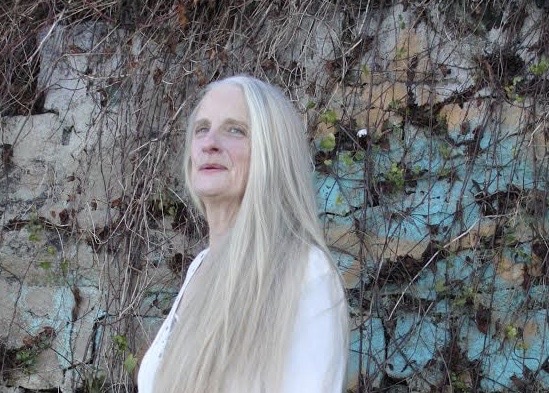
Sarah Lyon – Sarah is a professional cook and food writer, PGDip, MEd Child and Adolescent Psychotherapeutic Counselling, University of Cambridge, UK (2016), Pacific Jubilee Spiritual Direction program (2021). Sarah was awarded a first for her Masters dissertation, an exploration of practising therapy with the natural world in mind. Canadian born, she now lives in British Columbia, where she integrates her love of story writing and inquiry with her love for food, spiritual direction, psychotherapy and nature connecting activities to guide others towards inner and outer awareness. Sarah is also a participant in the SDI Webinar Series – Eco-Spiritual Direction in a Time of Eco-Crisis – Restoring the Great Conversation.

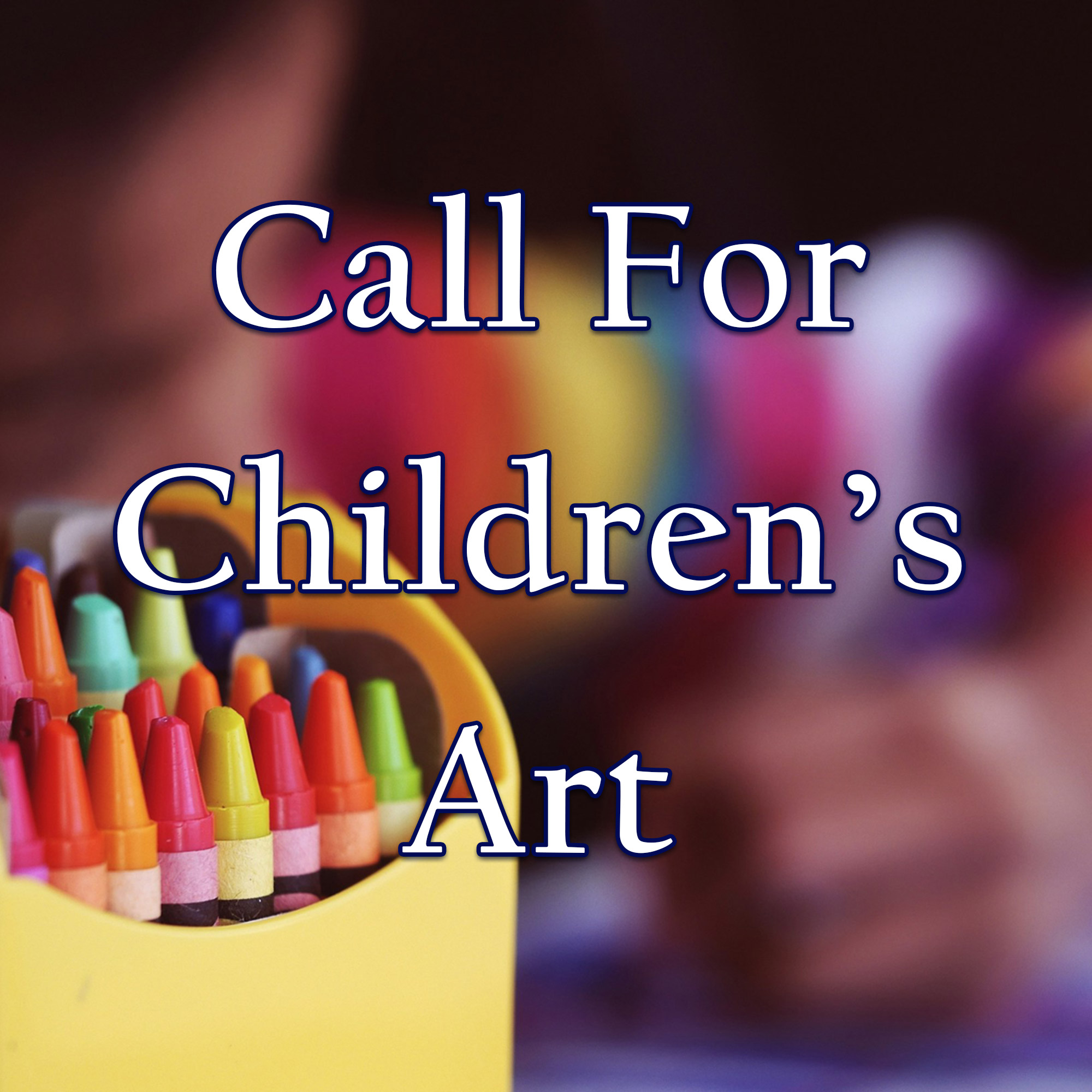

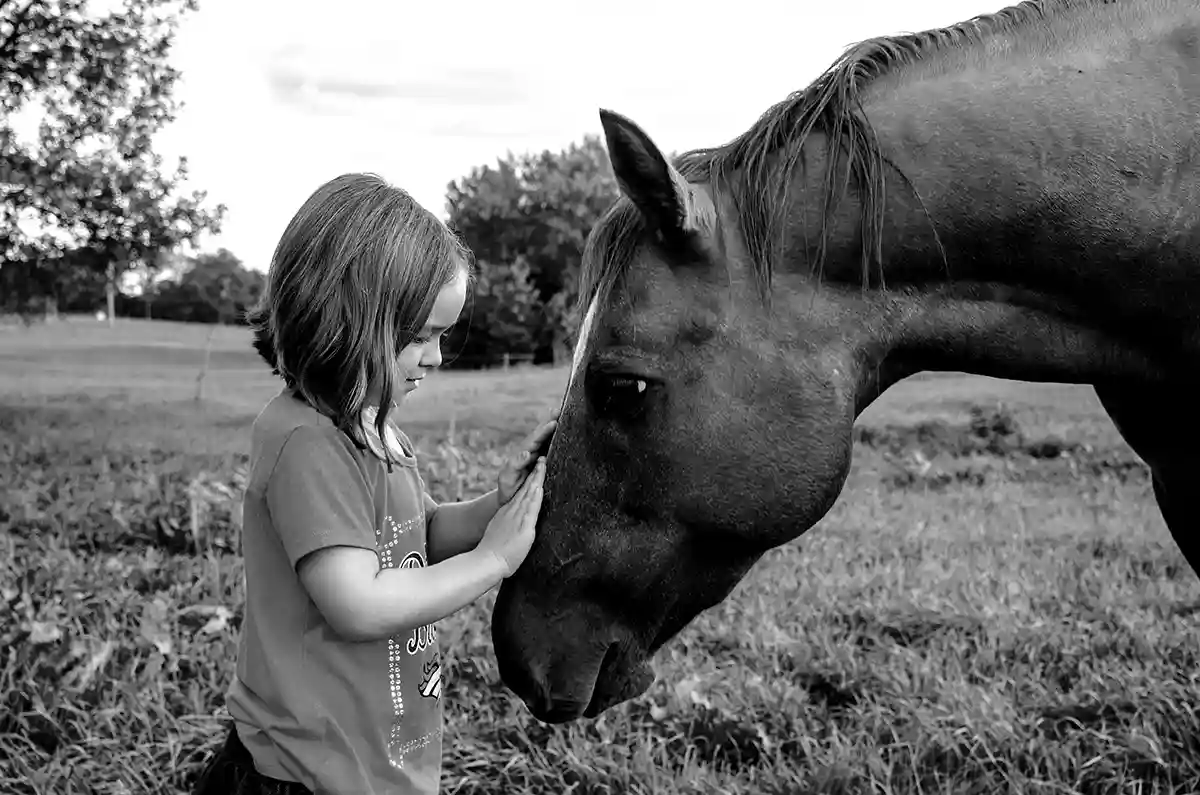
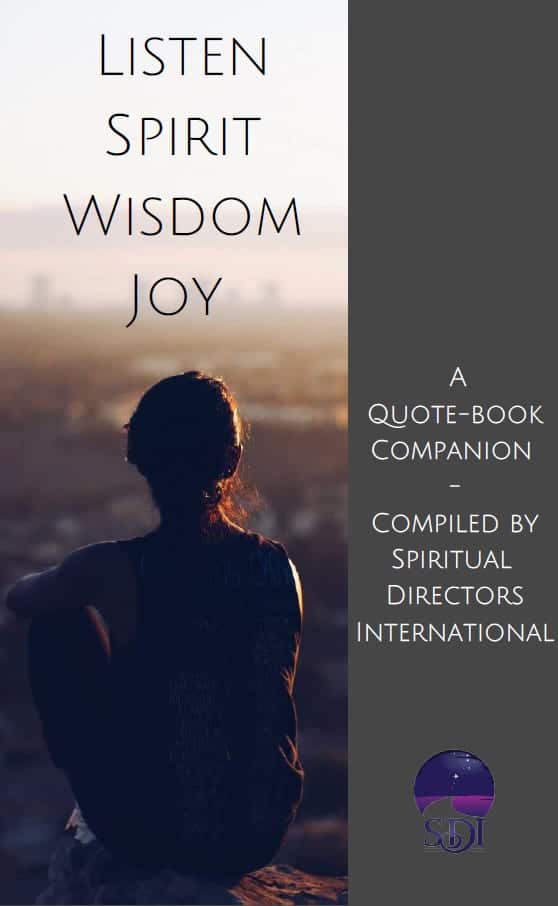
2 comentarios en “Hymn to Hummingbirds”
This is so beautiful and uplifting. I have my own hummingbird on my arm who protects me and helps me to remember to do what I can!
This is my homecoming as well. Thank you so much for sharing your story. It resonates deeply.